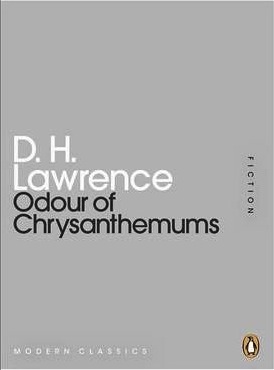
photo by Chris Fithall
The Embedded Narratives in D.H. Lawrence’s ‘Odour of Chrysanthemums’
~
by G. F. Phillips
For Lawrence, the struggle between the creative and destructive elements in class, gender, work and home are highlighted by possessiveness. Crucially, they are all interlinked to the industrial system of supply and demand. In this respect, an embedded narrative, ever-present, impinges on the lives of Lawrence’s industrial workers, so that the domestic squabbles are nearly always about work-related problems, like money or strikes, or associated problems, as in the working man’s drinking habit at the end of his shift, or after pay-out. Often, these characters live a life of falsehood or misconception, or are victims who have the need to accumulate wealth.
This domestic discord is what makes the embedded narratives in many of Lawrence’s mining stories work, causing tensions between the characters as they look to better themselves, or look to leadership as a way of forgetting or combating their present unsteady predicament. For instance, this idea of bettering oneself is the psychological aspect behind Lawrence’s ‘Fanny and Annie’, in which Fanny believes she can be more than the lady’s maid in her premarital adventure with Harry, the foundry worker. In ‘Her Turn’, the utilisation of money becomes an act of revenge for Mrs Radford.
As is often the case, the stories highlight social divisions. In ‘A Sick Collier’, the neighbourhood gossip sums up Mr and Mrs Horsepool bluntly: ‘she was too good for him’. This is because, as a cook, she is socially superior to a pitman. Then, in ‘Daughters of the Vicar’, the focus instead is on two women – Mary who married for money, against Louisa marrying for love.
Moreover, these relationships are all about power relations as a result of mismatches, some of which are sexual taboos; the modus operandi of Lawrence’s fiction.
More than anything, though, Lawrence speaks up for men over women. Here is the opening scene of ‘Odour of Chrysanthemums’:
It appeared round the corner with loud threats of speed … a woman, walking up the railway line to Underwood, drew back into the hedge, held her basket aside, and watched the footplate of the engine advancing. The trucks thumped past, one by one, with slow inevitable movement, as she stood insignificantly trapped behind the jolting black wagons and the hedge…
From the beginning, Lawrence’s words are deeply ingrained in the ‘entrapped will’ that encompasses the lone woman. The railway crossing itself acts as a division between entrapment and will; she is entrapped by one of the forces of industry, of progression – the locomotive, which has superseded the horse – and it reduces her into submission. The adverb ‘insignificantly’ coldly describes the woman’s entrapment, while the adjective ‘inevitable’ further conveys her fragility, alongside the ‘loud threats of speed’.
 Later in the story, Lawrence then insinuates these ‘threats’ are all in the woman’s mind. Passing miners see nothing out of the ordinary about a freight train that ‘trundles’ up to the pithead, yet the woman has seen this as something to fear.
Later in the story, Lawrence then insinuates these ‘threats’ are all in the woman’s mind. Passing miners see nothing out of the ordinary about a freight train that ‘trundles’ up to the pithead, yet the woman has seen this as something to fear.
A comparable scene from Women in Love has Gerald Crich control his mare’s nervousness of a noisy passing train. Sisters Ursula and Gudrun Branwen look on with sympathy for the suppressed mare. The figure of Gerald Crich and the bulky locomotive in both ‘Women in Love’ and ‘Odour of Chrysanthemums’ can remind the reader, as David Lodge has said in The Art of Fiction, that ‘industry has been imposed on the countryside by the masculine power and will of capitalism…’
The entrapped woman in the opening scene of ‘Odour of Chrysanthemums’ acts as a counter-point to the masculine power. Further, she is the precursor to the central character, Elizabeth Bates. The entrapped woman has her own embedded narrative; she is a frame figure, someone who leaves the story as soon as she has arrived, and yet, she helps establish a Schopenhauerian air of pessimism in the subsequent main narrative. As cited in Christopher Janaway’s Schopenhauer: A Very Short Introduction, Lawrence, who greatly admired Schopenhauer, utilised the idea that ‘the vanity of women is bad because it is centred entirely on material things and hence society is so very much their element’. In this story, the idea of pessimism is further enhanced by the dishevelled images of chrysanthemums, which signal the theme of decay and approaching death.
Elizabeth Bates’ embedded narrative emanates from her deep consciousness. The reader gradually receives a full, if not unresolved, picture of the divisions between her and her husband, Walter. Overall, self-preservation is the governing factor, and Elizabeth’s claim of love for her husband is sorely tested by his sudden death in a local pit disaster. Through his death she discovers the truth about their relationship and her part in it.
The reader first learns about their domestic discord before the pit disaster, when the driver of the freight train turns out to be Elizabeth’s father. Whilst Elizabeth gives him a cup of tea at the footplate, her father says, “I hear Walter’s got another bout on”. Her bitter reaction is exacerbated by his comment that “it’s a nice thing, when a man can do nothing with his money but make a beast of himself!”
Elizabeth’s father is only saying what she thinks and what she would not dare to say outright. The fact that she and her children must then ‘… await the father’s coming to begin the tea’ is a sign of obedience, routine and social convention within the patriarchal pit community of the time.
 Stylistically, the suspense of his supposed late homecoming from the pit helps support the idea of her entrapment, as dutiful wife and mother, sewing and seeing the children off to bed. Her will is one of inertia, seen, for instance, in the disrupted narrative, which gives way to a lively setting, where ‘all the life of the room seemed in the white, warm hearth and the steel fender reflecting the red fire’. The stark contrast between how she perceives the glow of the fire and its actual heat is symbolic of the way she feels deep-down towards her husband. She cannot feel the fire’s warmth, and there is a sense in which something in her life has made her feel, metaphorically, burnt out.
Stylistically, the suspense of his supposed late homecoming from the pit helps support the idea of her entrapment, as dutiful wife and mother, sewing and seeing the children off to bed. Her will is one of inertia, seen, for instance, in the disrupted narrative, which gives way to a lively setting, where ‘all the life of the room seemed in the white, warm hearth and the steel fender reflecting the red fire’. The stark contrast between how she perceives the glow of the fire and its actual heat is symbolic of the way she feels deep-down towards her husband. She cannot feel the fire’s warmth, and there is a sense in which something in her life has made her feel, metaphorically, burnt out.
From this otherwise homely setting of an English hearth, the story that now unfolds is seen from Elizabeth’s point of view. The building up of the coal fire, the dinner and the washing of Walter’s dead body, are all ceremonial rites. The final cleansing of the body is necessary for her to gain self-knowledge of her relationship: ‘She saw him, how utterly inviolable he lay in himself. She had nothing to do with him.’
Despite her active participation in preparing his body for the funeral rite, Elizabeth is beginning to understand that she has lived in a state of blindness and wishful-thinking:
… for his look was other than hers, his way was not her way. She had denied him what he was – she saw it now. She had refused him as himself. And this had been her life and his life. She was grateful to death, which restored the truth. And she knew she was not dead.
The points of separation in their relationship are clear in the contrasts – ‘his way was not her way’, and in her realisation that ‘she was not dead’. She has regained her semblance of will, but there is to be no further story, at least, not for them.
Unwittingly, in living a lie all this time, Elizabeth Bates’ tells us more about her part in ‘the entrapped will’ than Walter’s actions do. All along, it is Elizabeth’s refusal to accept the reality of the situation and the inability to confront him on, say, his drinking til late (which would have typically been the obvious excuse for his late homecoming) that contributes to an embedded narrative of misconception. One good example is in the answer to her child Annie’s query at bedtime, about her father still not having come home:
“Never mind. They’ll bring him when he does – like a log.” She meant there would be no scene “And he may sleep on the floor till he wakes himself. I know he’ll not go to work tomorrow after this!”
This is Elizabeth Bates in characteristic mode, avoiding any involvement, maintaining a quiet existence in her relationship with her husband.
However, needless to say, with Lawrence, it is never too late to discover the truth about one’s self or even one’s partner. One can pluck up the necessary courage to overcome some predicament, misdemeanour or moral dilemma. That he achieved it with such intensity of language and distinct polarity says much about Lawrence and his relationship to gender politics.
~
Gordon Phillips is an Adult Education tutor in Literature on Tyneside. His poems have been published in school textbooks and anthologies. He has written articles, book and theatre reviews for various magazines and has worked on several collaborations with composers. He is a member of The Society of Authors and the Performing Right Society. This piece forms one part of an extensive study of The Entrapped Will in D.H. Lawrence’s Short Stories.

